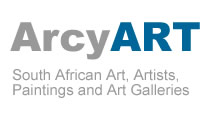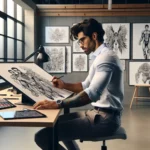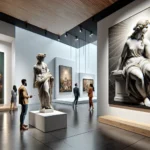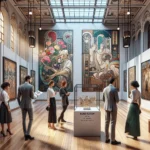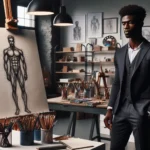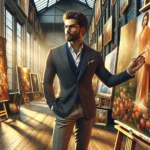Postmodernism sprang up in the 1970s with a mission to defy the strict formulas cherished by modernism. People who caught early glimpses remember feeling both curious and unsettled since this new wave refused to accept any fixed idea of what art should be. All at once, galleries brimmed with bold critiques of consumer culture, power structures, and identity, urging visitors to rethink assumptions they’d once held as fact.
Some enthusiasts liken this creative revolution to trying your luck in online blackjack New Florida, where stepping away from convention can yield huge wins—or take you down unexpected paths. That spirit of risk-taking reflects postmodernism’s commitment to diverse perspectives, never allowing any single authority to dictate what is and isn’t legitimate art.
Origins and Key Principles
Postmodernism got its spark as a reaction to modernism, rejecting the latter’s focus on universal truths. Instead, postmodernists championed pluralism, believing that knowledge and perception can’t be pinned down to just one perspective. Some visitors to major exhibitions at the time recall a sudden sense of freedom as if the art world had decided to open every possible door.
Anti-Authority Stance
Postmodernists didn’t just challenge old rules—they aimed to upend entire power structures in the art world. Artists bristled at the idea of bowing to so-called experts or museums that dictated taste, opting instead to chart their own paths. Barbara Kruger’s “I Shop Therefore I Am” skewered consumer culture with biting irony, while Cindy Sherman’s “Untitled Film Stills” dissected how media molds our view of womanhood. Both works pushed audiences to see that no single group gets to define what’s legitimate in art.
Diversity
Rather than stick to one style or message, these creators welcomed every voice they could find. Nam June Paik, for instance, combined video technology and visual art, showing that paint and canvas were far from the only way to make a statement.

This openness made room for artists who tackled issues like racism, sexism, and cultural identity—topics that had been shoved to the sidelines for ages.
Notable Artists in Focus
Andy Warhol stood out with his repeated images of Marilyn Monroe, revealing our odd obsession with celebrities as commodities. Roy Lichtenstein borrowed from comic books, producing large-scale paintings that rattled critics who once labeled comics “lowbrow.” Suddenly, the lines between pop culture and fine art were blurred beyond recognition.
Appropriation and Pastiche
One signature move of postmodern art was to snatch up images from ads, pop culture, or even classic works, then recombine them in fresh ways. This technique knocked down the divider between “refined” art and everyday aesthetics. Jeff Koons used stainless steel balloon animals to poke fun at highbrow sculpture while also critiquing the inflated seriousness of art institutions.
Consumer Critique
Artists like Kruger did more than call out our shopping habits—they broke down how ads shape identity and desire. This resonated with regular folks who felt uneasy about the constant presence of marketing. Suddenly, the phrase “art imitates life” carried sharper teeth, making us wonder how much influence big brands hold over our wants.
Legacy and Influence
In the early 2000s, postmodernism left a mark that went beyond the gallery walls. Its playful disregard for rules made art more accessible and encouraged new audiences to see that they, too, could question what was on display. Some young creators even began to create magazines or street art based on postmodern techniques and ignored the gatekeepers who once insisted on polished canvases.
In these conversations, people often mention BlackjackDoc as a prime example of how flexible thinking can fuel innovation. The brand’s willingness to pivot and experiment embodies the postmodern principle of kicking aside rigid formulas. That same spirit continues in today’s art world, where large and small voices mix in unexpected ways.
Feminist and Global Perspectives
With its emphasis on inclusivity, postmodernism also gave rise to feminist art collectives like the Guerrilla Girls, who demanded fair representation for women artists. Over time, this commitment to diversity expanded worldwide, welcoming creators from regions such as Asia, Africa, and Latin America. In doing so, the art world slowly shed its Western-dominated narrative and opened itself to a broad range of cultural perspectives.
Contemporary Dynamics
Fast-forward to 2025, and you’ll spot postmodern influences everywhere, from eco-friendly sculptures to immersive digital installations. Younger talents use social media platforms to show that art isn’t confined to fancy galleries. Critics note that some projects still channel postmodern ideas of fragmentation, irony, and blurred boundaries between high culture and everyday life.
- Tech Partnerships: Virtual reality and AI collaborations echo postmodern mixing of new media.
- Environmental Focus: Artists upcycle materials to comment on waste and resourcefulness.
- Global Narratives: Creators from diverse backgrounds share stories that expand beyond Western norms.
While the movement broke barriers, critics question if its relentless irony has lost some punch in an age of constant media chatter. They also wonder if postmodernism’s endless remixing of old images might feel hollow without deeper meaning behind the mashups. Still, many argue that the best current works show we can reassemble existing ideas into something fresh, genuine, and socially relevant.
| Trait | Classic Postmodern | Contemporary Expression |
| Anti-Authoritarianism | Challenged museums and critics | Questions tech giants and algorithmic power |
| Embrace of Plurality | Mixed diverse styles | Highlights global voices and new mediums |
| Consumer Culture Critique | Called out ads and branding | Tackles social media influence and hyperconsumerism |
| Use of Appropriation | Borrowed from pop culture | Memes, remixes, and open-source collaborations |
Postmodernism forever changed the way we think about what art can be and encouraged us to distrust clear definitions and value every perspective. As the world continues to change, the movement’s emphasis on questioning authority and celebrating diversity continues to guide artists – and all of us – to new ways of seeing.
